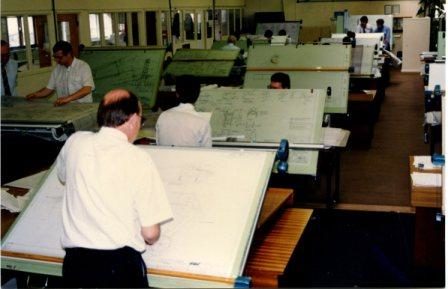E.T. Hone Home
October 22, 2024


 One of the interesting things about going to estate sales is trying to figure out what the sellers did with their lives. This past weekend it seemed like my own history was being revealed; two straight sales were full of drafting equipment!
Drafting boards are sought after by decorators but the scales, triangles, pencils, sharpeners, erasers, and compasses seem to be forsaken. Even worse is the fate awaiting the shelves upon shelves of reference books and catalogs — into a dumpster five minutes after the end of half-price day.
Judging by the age of their Machinery’s Handbooks, these gentlemen were ten or fifteen years older than me, so I imagine the CAD revolution was particularly tough on them. Neither home contained any evidence of a computer ever having been present.
I first sat down at a drafting board in the eighth grade, almost fifty years ago, and I finished my apprenticeship in 1973. High-tech then was a pre-printed Mylar form and automatic pencils. Our company drafting room had space for over forty huge drawing boards and a wall of giant, flat files for storing prints. A separate room with big exhaust fans was needed to make the actual blueprint copies. We even had a dedicated machine to fold the D- and E-size prints.
By the mid-1980s, computer-aided drafting (CAD) was moving into aerospace and defense work, the sectors able to afford the $25,000 “per seat” cost. But as the cost of the new technology began to fall, the improved productivity of CAD soon found its way to medium-sized industrial firms and the large drafting rooms started to shrink.
Imagine being an outdated dinosaur at age 35! That is certainly how I felt looking for a job with no CAD skills. It took me a while, but I eventually became proficient in this devil’s art and came to enjoy the flexibility it offered.
Now if I could only make the transition to 3-D.
One closing thought: fundamentals still count. The CAD programs popular in the beginning did not last long. People who were good board draftsmen (or draftswomen) were able to adapt those skills to a succession of platforms and programs. Those who were slow or sloppy on the board were about the same on the computer. CAD, it turns out, was efficient because it took away the mindless sharpening and re-sharpening of pencils and replaced it with rapid decision making.
One of the interesting things about going to estate sales is trying to figure out what the sellers did with their lives. This past weekend it seemed like my own history was being revealed; two straight sales were full of drafting equipment!
Drafting boards are sought after by decorators but the scales, triangles, pencils, sharpeners, erasers, and compasses seem to be forsaken. Even worse is the fate awaiting the shelves upon shelves of reference books and catalogs — into a dumpster five minutes after the end of half-price day.
Judging by the age of their Machinery’s Handbooks, these gentlemen were ten or fifteen years older than me, so I imagine the CAD revolution was particularly tough on them. Neither home contained any evidence of a computer ever having been present.
I first sat down at a drafting board in the eighth grade, almost fifty years ago, and I finished my apprenticeship in 1973. High-tech then was a pre-printed Mylar form and automatic pencils. Our company drafting room had space for over forty huge drawing boards and a wall of giant, flat files for storing prints. A separate room with big exhaust fans was needed to make the actual blueprint copies. We even had a dedicated machine to fold the D- and E-size prints.
By the mid-1980s, computer-aided drafting (CAD) was moving into aerospace and defense work, the sectors able to afford the $25,000 “per seat” cost. But as the cost of the new technology began to fall, the improved productivity of CAD soon found its way to medium-sized industrial firms and the large drafting rooms started to shrink.
Imagine being an outdated dinosaur at age 35! That is certainly how I felt looking for a job with no CAD skills. It took me a while, but I eventually became proficient in this devil’s art and came to enjoy the flexibility it offered.
Now if I could only make the transition to 3-D.
One closing thought: fundamentals still count. The CAD programs popular in the beginning did not last long. People who were good board draftsmen (or draftswomen) were able to adapt those skills to a succession of platforms and programs. Those who were slow or sloppy on the board were about the same on the computer. CAD, it turns out, was efficient because it took away the mindless sharpening and re-sharpening of pencils and replaced it with rapid decision making.